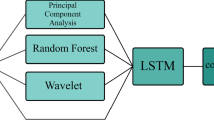Abstract
One futures market GARCH model prediction method based on Hessian matrix dynamic programming deep neural networks has been proposed to improve the prediction accuracy of futures market model. Firstly, data analysis has been made for futures market based on GARCH model. It takes twelve factors of today opening, the highest price, the lowest price, today closing, ups and downs, volume, SMA, 10BIAS, 10PSY, 10RSI, 10AR and 10BR as input variables, which is comparative series and then set up GARCH prediction model; secondly, Hessian dynamic programming deep learning network has been constructed, learning and training have been made for the established futures market GARCH model to improve prediction accuracy and efficiency; lastly, the effectiveness of this algorithm has been verified through simulation experiment.




Similar content being viewed by others
References
Vrontos, I.: Evidence for hedge fund predictability from a multivariate Student’s full-factor GARCH model. J. Appl. Stat. 39(6), 1295–1321 (2010)
Würtz, D., Chalabi, Y., Luksan, L.: Parameter estimation of ARMA models with GARCH/APARCH errors an R and SPlus software implementation. J. Stat. Softw. 55, 28–33 (2006)
Jin, W.: On electricity spot price properties by t-innovation GARCH model. Telkomnika Indones. J. Electr. Eng. 11(10), 5675–5683 (2013)
Ramírez, O.A., Fadiga, M.: Forecasting agricultural commodity prices with asymmetric-error GARCH models. J. Agric. Resour. Econ. 28(1), 71–85 (2003)
Augustyniak, M.: Maximum likelihood estimation of the Markov-switching GARCH model. Comput. Stat. Data Anal. 76, 61–75 (2014)
Ben-Ameur, H., Cref, H., Montréal, M., et al.: A dynamic programming approach for pricing derivatives in the GARCH model. Manag. Sci. 55, 252–266 (2005)
Rebennack, S.: Combining sampling-based and scenario-based nested Benders decomposition methods: application to stochastic dual dynamic programming. Math. Progr. 156(1–2), 343–389 (2016)
Tullsen, D.M., Eggers, S.J., Emer, J.S., et al.: Exploiting choice: instruction fetch and issue on an implementable simultaneous multithreading processor. In: International Symposium on Computer Architecture. IEEE, pp. 191–191 (2005)
Chaparro, P., Gonzalez, J., Magklis, G., et al.: Understanding the thermal implications of multi-core architectures. IEEE Trans. Parall. Distrib. Syst. 18(8), 1055–1065 (2007)
Hari, S.K.S., Adve, S.V., Naeimi, H., et al.: Relyzer: exploiting application-level fault equivalence to analyze application resiliency to transient faults. Comput. Arch. News 40(1), 123–134 (2012)
Freitas, F.D., Souza, A.F.D., Almeida, A.R.D.: Prediction-based portfolio optimization model using neural networks. Neurocomputing 72(10–12), 2155–2170 (2009)
Bollerslev, T., Jeffrey, M., Wooldridge, J.M.: Quasi-maximum likelihood estimation and inference in dynamic models with time-varying covariances. Econom. Rev. 11(2), 143–172 (1992)
Hamilton, J.D., Susmel, R.: Autoregressive conditional heteroskedasticity and changes in regime. J. Econom. 64(1–2), 307–333 (1994)
Sentana, E., Fiorentini, G.: Identification, estimation and testing of conditionally heteroskedastic factor models. J. Econom. 102(2), 143–164 (2001)
Patton, A.J.: A review of copula models for economic time series. J. Multivar. Anal. 110(5), 4–18 (2012)
Mizrach, B.: Inference and forecasting for ARFIMA models with an application to US and UK inflation. Stud. Nonlinear Dyn. Econom. 8(2), 1218 (2004)
Wang, L., Wu, W., Xu, Z., et al.: BLASX: a high performance level-3 BLAS library for heterogeneous multi-GPU computing. In: International Conference on Supercomputing. ACM, p. 20 (2016)
Arunkumar, N., Ramkumar, K., Venkatraman, V., Abdulhay, E., Fernandes, S.L., Kadry, S., Segal, S.: Classification of focal and non focal EEG using entropies. Pattern Recogn. Lett. 94, 112–117 (2017)
Arunkumar, N., Kumar, K.R., Venkataraman, V.: Automatic detection of epileptic seizures using new entropy measures. J. Med. Imaging Health Inf. 6(3), 724–730 (2016)
Enas, A., Mazin-Abed, M., Dheyaa-Ahmed, I., Arunkumar, N., Venkatraman, V.: Computer aided solution for automatic segmenting and measurements of blood leucocytes using static microscope images. J. Med. Syst. (2018). https://doi.org/10.1007/s10916-018-0912-y
Arunkumar, N., Ramkumar, K., Venkatraman, V.: Entropy features for focal EEG and non focal EEG. J. Comput. Sci. (2018). https://doi.org/10.1016/j.jocs.2018.02.002
Hamza, R., Muhammad, K., Arunkumar, N., González, G.R.: Hash based encryption for keyframes of diagnostic hysteroscopy. IEEE Access (2017). https://doi.org/10.1109/ACCESS.2017.2762405
Fernandes, S.L., Gurupur, V.P., Sunder, N.R., Arunkumar, N., Kadry, S.: A novel nonintrusive decision support approach for heart rate measurement. Pattern Recognit. Lett. (2017). https://doi.org/10.1016/j.patrec.2017.07.002
Arunkumar, N., Ramkumar, K., Venkatraman, V., Abdulhay, E., Fernandes, S.L., Kadry, S., Segal, S.: Classification of focal and non focal EEG using entropies. Pattern Recognit. Lett. 94, 112–117 (2017)
Author information
Authors and Affiliations
Corresponding author
Rights and permissions
About this article
Cite this article
Lei, D. GARCH model prediction method based on Hessian matrix dynamic programming deep neural network. Cluster Comput 22 (Suppl 2), 4361–4366 (2019). https://doi.org/10.1007/s10586-018-1895-7
Received:
Revised:
Accepted:
Published:
Issue Date:
DOI: https://doi.org/10.1007/s10586-018-1895-7




